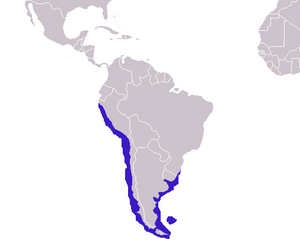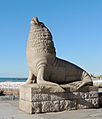South American sea lion facts for kids
Quick facts for kids South American sea lion |
|
|---|---|
 |
|
| Male and female | |
| Conservation status | |
| Scientific classification | |
| Genus: |
Otaria
|
| Species: |
flavescens
|
 |
|
| South American sea lion range | |
| Synonyms | |
|
Otaria bryonia |
|
The South American sea lion (Otaria flavescens) is a fascinating type of sea lion. People also call it the Southern Sea lion or the Patagonian sea lion. You can find these amazing animals living along the coasts of several South American countries. They live in places like Ecuador, Peru, Chile, the Falkland Islands, Argentina, Uruguay, and southern Brazil. It is the only member of its special animal group, called the genus Otaria.
Contents
About South American Sea Lions
South American sea lions are large, powerful marine mammals. They spend a lot of their time in the ocean. However, they also come onto land to rest, warm up in the sun, and have their babies. These sea lions are well-adapted to life both in the water and on rocky shores.
What They Look Like
South American sea lions have a thick, furry coat. Adult males are much larger than females. Males can grow up to 2.8 meters (about 9 feet) long. They can weigh up to 350 kilograms (about 770 pounds). Females are smaller, reaching about 2.2 meters (7 feet) long. They weigh around 150 kilograms (330 pounds).
Color and Features
Males usually have a darker, brownish-black fur. They also have a very thick, mane-like fur around their necks. This mane makes their heads look even bigger. Females are often lighter in color, with a yellowish-orange or light brown fur. Both males and females have strong flippers. These flippers help them swim fast in the water. They also help them move around on land.
Where They Live
South American sea lions live along the long coastline of South America. Their home stretches from Ecuador in the north, all the way down to the southern tip of Argentina. They prefer rocky beaches and islands. These places offer safe spots for them to rest and raise their young.
Their Coastal Home
These sea lions are often seen on sandy beaches too. They like areas where they can easily get into the water. They also need places where they can escape from predators. Their wide range means they can adapt to different coastal environments.
What They Eat
South American sea lions are carnivores. This means they eat meat. Their diet mainly consists of fish. They are skilled hunters in the ocean.
Hunting for Food
They eat many kinds of fish, including hake and anchovies. They also eat squid, octopus, and even some crustaceans like crabs. Sea lions use their excellent eyesight and whiskers to find food underwater. They are very good at diving deep to catch their prey.
How They Behave
South American sea lions are very social animals. They often gather in large groups called colonies. These colonies can have hundreds or even thousands of individuals.
Social Life and Sounds
Within these colonies, males often fight for control of territories. They make loud roars and barks. These sounds help them communicate with each other. Females also make sounds to call their pups. Sea lions are quite playful. They can be seen interacting with each other in the water. They also enjoy basking in the sun on rocks.
Reproduction and Life Cycle
The breeding season for South American sea lions usually happens in the summer months. This is when males try to attract females.
Pups and Growing Up
Females give birth to a single pup. The pup is born on land. Pups are born with a dark, woolly coat. They are usually about 75-80 centimeters (around 30 inches) long. They weigh about 10-15 kilograms (22-33 pounds). The mother takes care of her pup for several months. She feeds it milk. Pups learn to swim and hunt from their mothers. They gradually become independent. South American sea lions can live for about 20 years in the wild.
Images for kids
See also
 In Spanish: Lobo marino sudamericano para niños
In Spanish: Lobo marino sudamericano para niños







